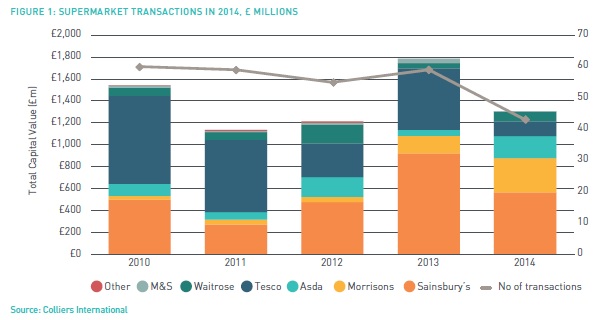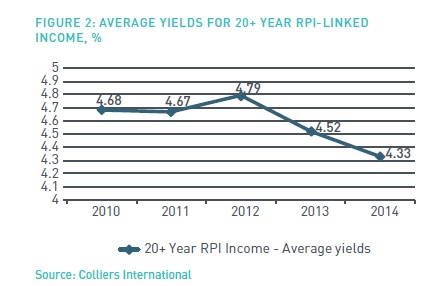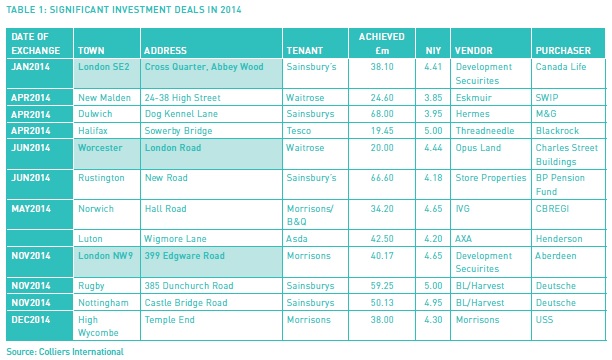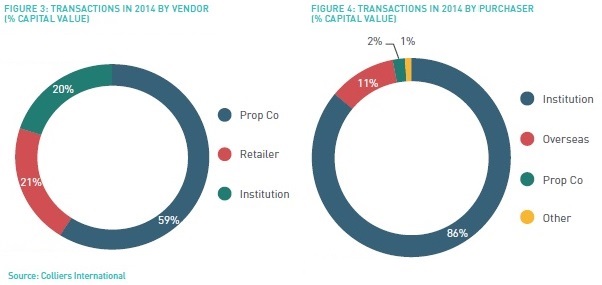Documents:
The investment market in 2014
It was inevitable that the turbulence in the supermarket sector during 2014 would also be reflected in its property investment market.
In last year’s report, we cautioned that simply ‘buying income’ was not the way f orward in a sector where assets are influenced both by property fundamentals and also the operational viability of the s tores which inhabit the spaces being traded.
This point came into sharp focus last year as the Big Four battled with new competition, lower resultant margins and also the growth in non-profitable internet retailing. Against this backdrop, the supermarket investment market has now developed a clearly defined secondary market.

Transactional volumes down
With the media full of headlines about the difficulties f acing the major operators, it was hardly surprising that this affected investor sentiment, but 2014 s till remained above the annual average of around £1bn of transactions.
Although transactional volume was down 27% to £1.3bn (2013: £1.8bn) there was still assiduous buying by investors. Deal volumes peaked in Q2 2014 at £500m and dipped thereafter as the depth of pr oblems facing the operators became increasingly obvious.
This demonstrates the resilience of the sector and also the appetite for index-linked leases which underpin the majority of traded assets. This lease feature and the underlying continued covenant strength of the Big Four has ensured that there have not been investor defections on the scale that might have been envisaged.
Prime remains strong
It was the secondary market that bore the brunt of changed investor sentiment, whilst prime remained resilient.

Given the inherent uncertainty that has characterised the market in the past year, prime yields have not moved significantly, investors remain keen on strong, healthy, right-sized stores in good demographic locations. These remain liquid assets.
Yields have softened for flawed stores which are overrented, face considerable competition or suffer fr om a lacklustre demographic. There is no longer an obvious replacement tenant and residual values have been adversely affected.
Institutional investors have responded by discreetly looking to exit fr om the poorer stores in their portfolios, more often than not at yesterday’s valuation. The market is resisting this leading to a significant increase in supply. Conversely, prime supermarket investments remain thin on the ground which is also supporting their values.

Rents
The relationship between assets let on RPI-linked leases and those on Open Mark et rents (OM) changed during the year. Over the past few years, inflation has – through the RPI linkage – grown rents well ahead of open mark et rents.
Most recently open market rents have dropped back, but RPI – while also slowing in its upward progress – has still been increasing rents. This is leading to over-renting in some areas of the market, and is a phenomenon that the sector will have to deal with in the same way as the other retail subsectors
Development pipeline
Tesco’s decision in 2014 not t o fit-out out a ne w store in Chatteris to which it was committed on a 25-year lease was a watershed moment for the supermarket development sector and the forward funding market that enables it.
Forward funding in 2013 ac counted for 20% by value of all supermarket investment activity. This fell to around 18% last year and there will be a signific ant reduction in supply and demand for these deals in 2015 until the oc cupational market reaches equilibrium.
There are still incidences of forward funding but these are limited to the strongest of locations – primarily within the M25 – wh ere the tenant’s commitment is undoubted.
There are locations wh ere the operators continue to expand. A good example is East London which is by no means o verprovided and is demographically progressive. London is expanding and eastwards down the Thames corridor is an obvious direction for it to head. The emerging strength of locations such as Shoreditch, Dalston, Stoke Newington is now spreading to places such as Barking, Str atford and beyond. Affluent catchments also continue to prove attractive with new stores opening in locations including Guildford, Oxford and Bagshot, later this year.
An institutional market
The investor profile for the supermarket sector remains essentially unchanged. In 2014, UK institutions accounted for 86% of all purchasing activity, very much in line with 2013.
Last year’s report noted that the market had seen the arrival of overseas buyers predominantly fr om the Far East who were typically looking for less-than-prime stores at yields of around 5%. They ended up with 11% of the mark et in 2014 fr om a standing start, and we expect this demand will continue to build with a greater diversity of nationalities.
This year we may see a rise in sal es by institutions as some investors look to reduce their exposure to the sector. With 2014 returns from supermarkets looking underwhelming in comparison to other property asset types, some owners will look to sell and an equalisation in v aluations will lead to a number of these stores heading offshore.

Supply
Prior to last year, Tesco and then Sainsburys had been the principal supplier of investment grade, sale-and-leaseback product, but in 2014 it was Morrisons who were dominant. A relatively late arrival to the party, they made up for lost time with the successful £500m program of disposals (of which £300m were food stores) that ex-Chief Executive Dalton Philips had outlined to their shareholders in March 2014.
The operators have now predominantly called a halt to sale-and-leaseback activity and we do not expect them to be a major supplier of pr oduct in 2015. Whilst this would normally mean a reduction in supply we believe the shortfall will in part be met by the disposal of s tores held in JV’s with others.
The discounters
Barely a week went by in 2014 without the media r eporting how the discounters were taking chunks out of the Big Four’s market share. Whether this will be sus tained is more of a moot point and ther e are indications that there will be a finite market share for the discount offer. What cannot be denied – and this may be the disc ounters’ lasting legacy – is that they have forced down profit margins across the sector.
Outlook
The problems that the supermarket sector has faced in the past year have perhaps been exaggerated.
As a business sector, it certainly faces substantial challenges and, in the medium-t erm, some will pay the price for over-exuberant expansion.
Margins and profitability are down but, at its c ore, the supermarket business remains robust. Tesco has been the target of most negativity and yet is still a business that even during the chaos of 2014 achie ved a £1bn+ profit.
So wh ere does that leave the property investor looking to buy supermarket assets?
Areas of the market are definitely in motion. We think yields will deservedly hold fast for the prime, healthy product, where the investor is less sensitive to lease structure.
But returns for open market stores are being affected and the secondary market has more pain to come. The current average yield gap between prime and secondary assets is simply not wide enough t o reflect the inherent risk profiles of these assets.
For all operators, it is the consumer’s increasing predilection for online delivery topped up by convenience basket shops leading to the demise of the super pr ofits generated by the traditional trolley shop that is at the heart of their problems. Grocery delivery is not an area wh ere the operators can make profits – yet.
However, whilst we have discussed the internet’s disruption of the occupational market at length, it is worth considering the positive effect Quantitative Easing will continue to have on the investment market for these assets in 2015. Gilt yields have hit record lows as returns on sovereign debt have fallen across the globe, and as the ECB embarks on its own Eurozone stimulus programme it is probable yields on alternatives such as property will remain attractive in comparison. In turn, within the pr operty sub-sectors returns from supermarkets continue to compare favourably to those available in the Office & Industrial sectors.
So operators are heading into an era of lower margins. They are going to make less profit, and that has t o be factored into the sector’s underlying property investment market.
However, the inherent strengths of the sector remain and if investors can also get the property fundamentals right then there are consistent, long and strong returns on offer.

 Meet Saluhall, the first plant-forward food hall in San Francisco
Meet Saluhall, the first plant-forward food hall in San Francisco  Coach files trademark complaint against Old Navy
Coach files trademark complaint against Old Navy  Ingka opens unique culinary development in downtown San Francisco
Ingka opens unique culinary development in downtown San Francisco  McDonald's to acquire franchised stores in Israel
McDonald's to acquire franchised stores in Israel  Amazon removes Just Walk Out tech from all of its stores in the US
Amazon removes Just Walk Out tech from all of its stores in the US